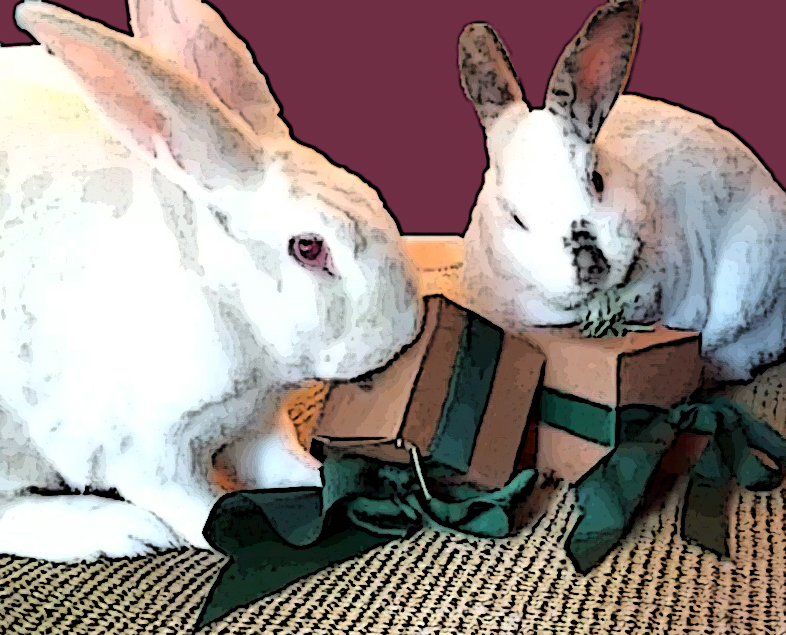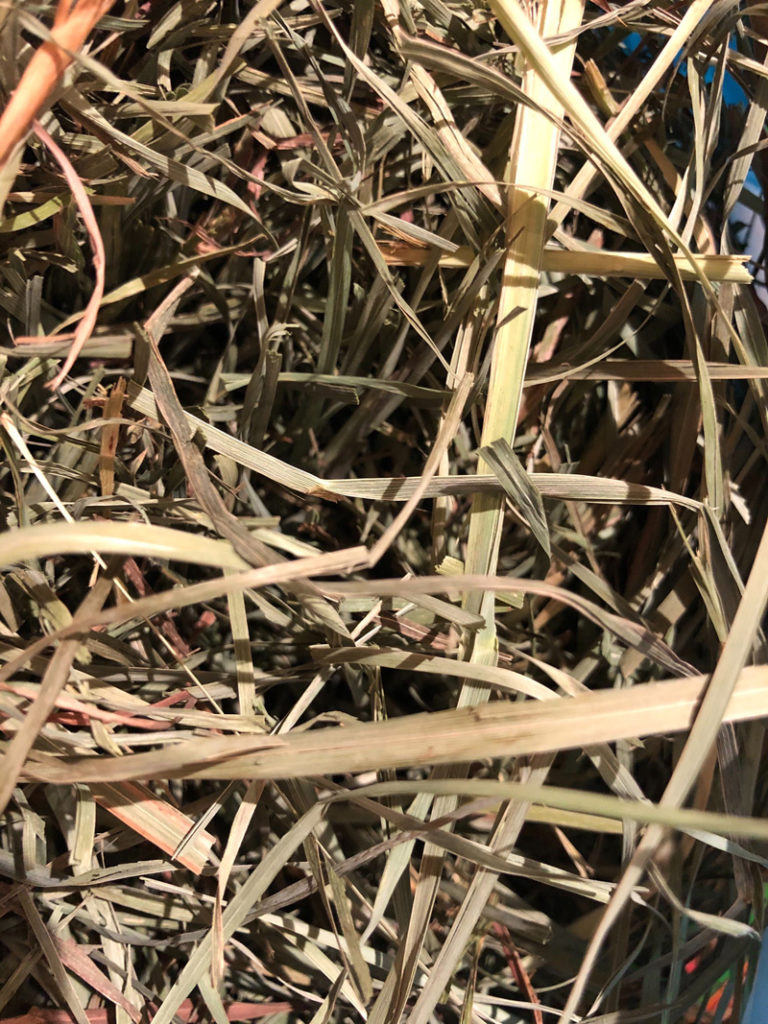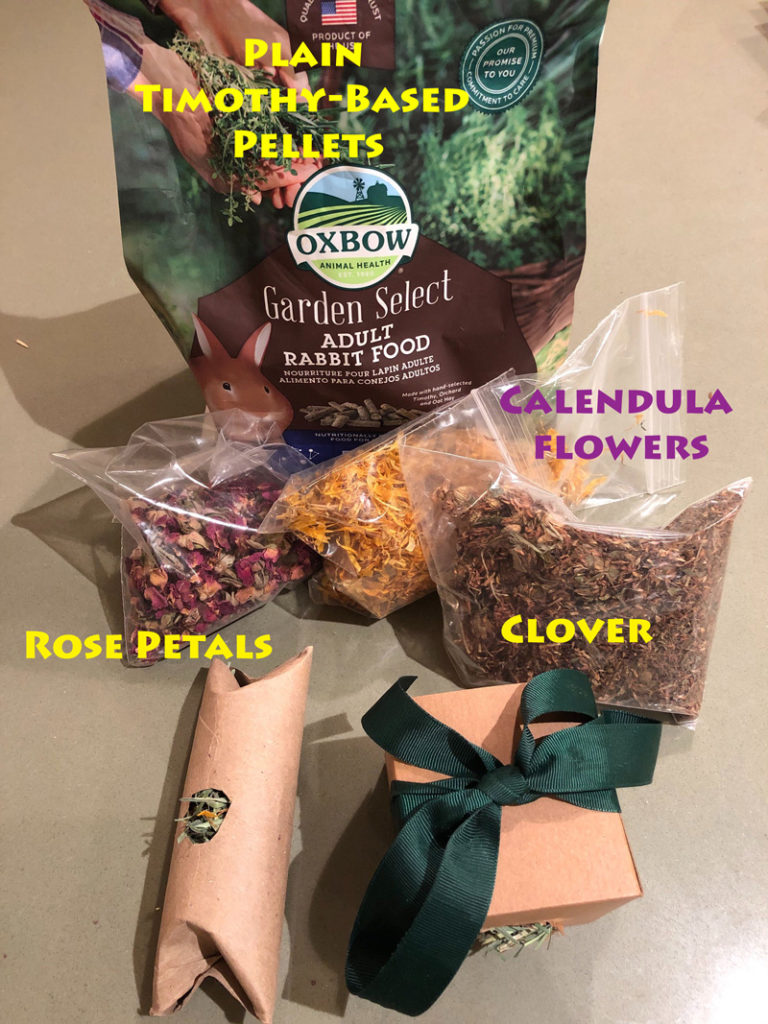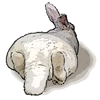
Something to do! Everybody needs something to do, including pet rabbits. Besides just giving your bunster a rockin’ good time, it also helps keep them from doing things you might not like them doing! But how to give your bunny a steady supply of entertainment without breaking the bank? One way is to make your own puzzle toys.
A puzzle toy is simply a rabbit-safe object that hides food. Your bunny should be able to detect the presence of the food, and then do something rabbity, like dig — or chew — or pull — to get at the food. Presto! He not only gets something tasty to eat, he also gets an activity he’ll enjoy. Here’s a step-by-step guide to creating puzzle toys for your whisker-nosed friend.
Step 1: Gather Your Materials
 The Containers
The Containers
Cardboard is a low-cost material commonly used for puzzle toys. Many people use the cardboard core of a toilet paper or paper towel roll. This costs nothing for most of us since we are going to end up with a lot of them no matter what.
Recently I splurged on a nicer container – 3″ x 3″ plain brown cardboard gift boxes. I got 150 of them for $15 plus shipping, so even with the cost, it was not extravagant. One advantage of the gift boxes over the t.p. rolls is that the boxes are a bit bigger and heavier. The additional bulk makes it easier for the rabbit to pull stuff out of them.
You could also save small cardboard boxes that come your way from mail order packages. I avoid printed or finished cardboard – the more plain / raw the better. Make sure to use containers that are small enough that your bun can’t just climb on in. Once his head and forepaws are inside, it’s no longer a puzzle, it’s a smorgasbord!
The Main Filler: Hay
 Your puzzle toy should contain primarily hay. If you fill the thing with richer treats, it will be like letting a little kid eat the whole Halloween haul in one go. Not healthy! The only difference is the rabbit can’t throw up afterwards! (That’s really true, rabbits can’t vomit.)
Your puzzle toy should contain primarily hay. If you fill the thing with richer treats, it will be like letting a little kid eat the whole Halloween haul in one go. Not healthy! The only difference is the rabbit can’t throw up afterwards! (That’s really true, rabbits can’t vomit.)
Since I fill the litterboxes with timothy hay all day long, I look for an alternative hay to go in the toys to make them more interesting. Orchard grass is nice because it’s usually less coarse than timothy, so it’s a lot easier to stuff into a small container.
Another idea is to fill mostly with timothy but add a pinch of alfalfa. Just keep in mind that you need to keep the amount small, unless your rabbit is very young or very old. Baby and geriatric buns need the extra protein. Adults will just get fat!
 Treat Surprises!
Treat Surprises!
For the pièce de resistance, you can sprinkle in a few special things to really get your bunny excited about the toy; a few small slivers of rabbit cookie or tiny morsels of dried fruit, for example. You can also use dried rabbit-safe flowers such as clover, rose petals, calendula, chamomile, or lavender. Or you can just use plain timothy-based rabbit pellets (cereal).
Step 2: Assemble Your Puzzle Toys
Now you simply put it all together.
For toilet rolls, many people just stuff them and leave the ends open. I like to fold in the ends so in case I don’t stuff it real tight, the goodies will still stay inside. I start with one end closed. With the gift boxes, I just assemble the box, leaving the lid open.
Then start alternately adding a little bit of treat and a bunch of hay — treat, hay, treat, hay — like a lasagna, until the container is full. Then close it off.
Step 3: Final touches
You can try just handing over the puzzle toy at this point and see what happens.
I find that in most cases my guys aren’t going to do much more than sniff at it unless there is a clear entry point. If the same is true of your bun, poke some holes to get them started. The hole needs to be big enough for them to get their noses into and get a chew-hold, but not big enough for them to get in more than a nose. It also helps get them started if you pull a little tuft of hay out the hole.
With the gift boxes, Finnegan, our big ruby-eyed white ruffian, will quickly pop the lid if he can. Then we have treat free-for-all! Where’s the sport in that? So I make sure he can’t.
A simple approach I’ve found that works is to tie a ribbon around it. I have plenty of gift box ribbon that I’ve saved from Christmases and birthdays past. It comes in quite handy for this purpose! They’re just garden-variety polyester ribbons. I don’t worry about them being rabbit safe because I’ve watched closely and my buns don’t have any interest in chewing on them. If yours do, you can opt for a plain cotton or some other natural fiber to tie your box with. Tie it tight so it can’t be slipped off!
And now the best part: giving your fuzzy friend a fun, healthy treat!
More Money than Time?

You can find a lot of puzzle toys for sale on the web. My favorite source is Bunny Bytes. I’ve been a loyal customer of theirs for over a decade. Though there are many great rabbit toy suppliers out there, I still haven’t found a site online that has a better selection of puzzle toys for bunnies.
My favorite is the “Nifty Gifty”, which is what inspired me to use the gift boxes for these toys. It’s a good deal fancier and a bit richer than the ones I make — it’s got a cookie in it, among other things. So I reserve them for special occasions!
Bunny Bytes was also the supplier for the dried flowers I used in the videos.
To be very clear, Bunny Bytes has no idea I’m posting this, and I’ve received nothing from them in regards to this endorsement. I just like their toys! If you have a favorite puzzle toy source, please add it to the comments.
 The Fuzzy Tail of This Blog Post
The Fuzzy Tail of This Blog Post
Making puzzle toys for your pet bunny can be very easy and cheap to do. Some cardboard containers, hay, treats and possibly some ribbon are all you need. Set up an assembly line for thirty minutes and you can crank out many days of happy activity for your long-eared friend!